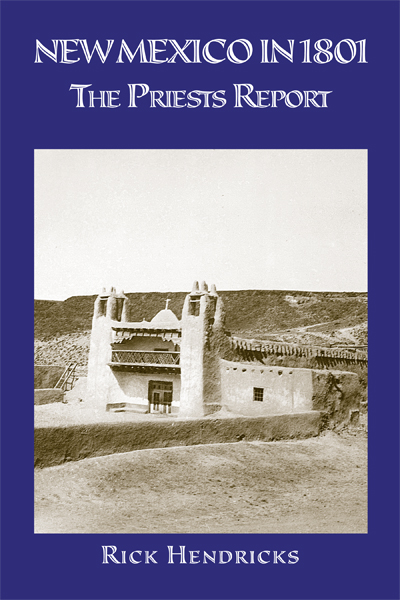The Priests Report
by Rick Hendricks
206 pages
$17.95/PB (978-1-890689-23-0)
 FINALIST, 2008 NEW MEXICO BOOK AWARDS
FINALIST, 2008 NEW MEXICO BOOK AWARDSSelected as 16th Most Popular Southwest History on Amazon.com (10/8/08)
Rick Hendricks appeared on National Public Radio to talk about his book. Listen to him by clicking the button below:

BOOK REVIEWS
The title says it all: For this collection, author Rick Hendricks gathered and translated 26 reports written about New Mexico in 1801 by the territory’s Roman Catholic clergy. In that year, the Consulado (Merchant Guild) of Guadalajara requested that the priests send information about the “state and circumstances of agriculture, industry, and commerce” in the New Mexico territory, with the hope that they could use the data to foster economic growth. The result is an intimate view of the territory, from the status of the roads to the clash between the Spanish and Pueblo cultures. The reports, which Hendricks admits that he has translated for historical accuracy rather than for ease of reading, are for the serious student of history who wants to consult primary (or nearly so) sources.
Hendricks, the author or co-author of 16 books, was an editor for the Vargas Project, a historical editing project dedicated to publishing the official papers of Governor Don Diego de Vargas (1643-1704). He currently works in the Archives and Special Collections Department at New Mexico State University, where he also teaches Latin American history. – New Mexico Magazine, January 2009
There are different kinds of history books, reader-friendly like Don Bullis’ Biographical Dictionary (Volume II is reviewed on this website), suited to the general reading audience. Then there are the history books that are too much like the texts we groaned through in school.
New Mexico in 1801: The Priests Report is that kind of history book. Specifically, it is a primary source book, chiefly interesting to the academic historian, although not impossible for the general interest reader. The Merchant Guild of Guadalajara requested these reports: the 20 priests replied with formulaic letters describing conditions in 28 pueblos, or curacies. The Guild desired specific information about each pueblo: what was the state of agriculture in each curacy? What kinds of livestock were raised? What was the condition of the roads? In all, there were eight questions the priests were to address.
I won’t try to enumerate the answers to these questions, but like Don Bullis’ book, knowing the lands the priests are describing enriches the reader. When Father José de Vera of Taos writes of his mission “at the foot of a sierra and in a valley of the same name . . .” it is useful to picture for oneself hulking Taos Mountain and the great sweep of Taos valley.
Bit by bit, the text gives up information of interest. The census figures included in each report are a valuable contribution to what we know about Nuevo Mexico of the time. The figures are divided by gender and race, so we see how many men and women lived in the pueblos, and how many were Indians and how many non-Indians. These figures include the baptisms, marriages, and burials of 1801.
That the Spanish priests all learned to write in a formal manner, lacking the individual voice, can’t be helped. We have the occasional spark, “I would regret leaving in the inkwell . . .” (Father José Rubi of Santa Ana.) Or Father José Mariano Rosete on the bridge across the Rio Grande near his curacy at Santa Cruz, “In crossing it accidents often occur. . .there are no architects who understand bridges.” The frontier also had its hazards. At Abiquiu, Father José de la Prada complained of the Utes, “They go around like a gang of highwaymen . . .The damage this nation does is incredible.”
Hendricks’ introduction gives some valuable background, and his notes are quite helpful. He includes a glossary, and short biographies of the priests, some of whom were embroiled in almost telenovela style controversies (not related to the reports).
A little more interpretation would have been helpful. Hendricks does not place these reports in the context of the long occupation of Spain in the New World, or the coming independence of Mexico, 20 years in the future. He does not shy away from the race question, but he doesn’t have much to say about the state of the Indian mind that so frustrated the priests. The natives “applied themselves very little,” were very poor, and not willing to be taught, either. What conquered people willingly adopt the culture of those who have subjugated them?
The documents being in the Spanish voice give us no interpretation, none of the native point of view. However, historians will now be able to read between the lines of these primary source documents.
Hendricks successfully arranged punctuation and paragraphs, but I have a quarrel with how the book is formatted. For one, the text lacks quotation marks. For another, the formatting is misleading to the reader, making it difficult to distinguish when each priest’s report concludes and the next one begins. The Table of Contents is meant to make up for this deficiency, but it does not substitute for the appropriate use of heading fonts, white space, and quotation marks that would have smoothed the way for the reader. I can’t help but think Rick Hendricks’ painstaking work could have been better served.
New Mexico in 1801: The Priests Report is truly for the history specialist. I cannot imagine the difficulty of translating hand-written documents in 200-year-old Spanish, but this book adds to the understanding and interpretation of New Mexico when it was still a remote and impoverished province of New Spain. -- www.readingnewmexico.com

Rick Hendricks received a B.A. in Latin American History from the University of North Carolina-Chapel Hill and a Ph.D. in Ibero American History from the University of New Mexico where he was an editor on the Vargas Project, a long-term, historical editing project dedicated to the transcription, translation, annotation, and publication of the papers of Governor Diego de Vargas. Hendricks is currently employed at New Mexico State University where he works in the Archives and Special Collections Department and teaches classes in Latin American history in the History Department. The author or co-author of sixteen books and more than seventy articles and book chapters, Hendricks most recently published The Witches of Abiquiu: The Governor, the Priest, the Genízaro Indians, and the Devil with Malcolm Ebright. He is currently at work on two projects related to Church history: a biography of Antonio Severo Borrajo, a Spanish priest from Galicia who accompanied Jean Baptiste Lamy to New Mexico and later settled in the El Paso del Norte area and a study of the ecclesiastical visitation of Juan Bautista Ladrón del Niño de Guevara to New Mexico in the second decade of the nineteenth century.

